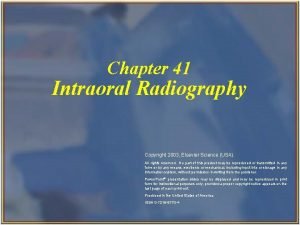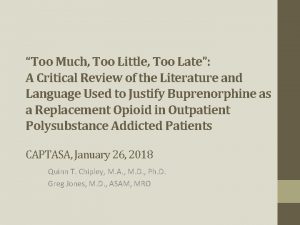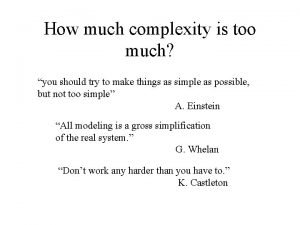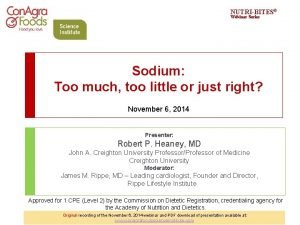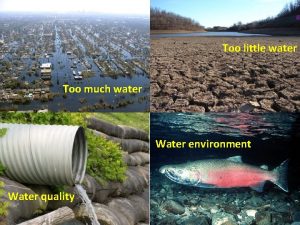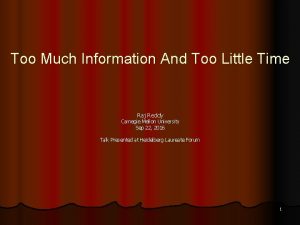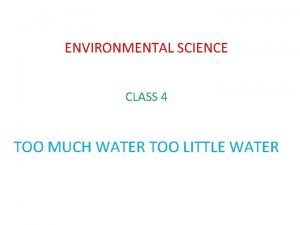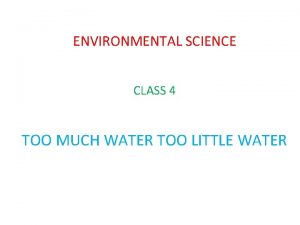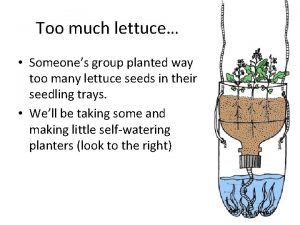You Can Never Have Too Much Data Lessons






































- Slides: 38

You Can Never Have Too Much Data – Lessons from Soil Re-sampling at Hubbard Brook Chris E. Johnson Syracuse University


http: //www. lternet. edu

The Hubbard Brook Experimental Forest • Established in 1955 by the USDA Forest Service for hydrologic research. Hubbard Brook Ecosystem Study • Initiated in 1963 using the small watershed approach to study hydrologic cycle-element interactions in small undisturbed and humanmanipulated forest ecosystems.





Characteristics of the Hubbard Brook Experimental Forest Bedrock Quartz Mica Schist and Quartzite Landscape Till-Mantled Glacial Valleys Soils Spodosols (Typic Haplorthods) p. Hw Oa 3. 9 Mineral Soil 4. 3 %BS 50 12 Vegetation Northern Hardwood Forest; Cutting 1915 -17; 80 -90% Hardwoods, 10 -20% Conifers Climate Humid Continental, Mean Precipitation 1400 mm

Hubbard Brook Experimental Forest


Characteristics of Monitored Watersheds Watershed Number Size (ha) Year Started Treatment 1 11. 8 1956 Calcium silicate addition 1999 2 15. 6 1957 Clear-felled in ‘ 65 -66, no products removed, herbicide application ‘ 66, 67, 68. 3 42. 4 1958 None – Hydrologic reference. 4 36. 1 1961 Clear-cut by strips in three phases – ‘ 70, 72, 74. Timber products removed. 5 21. 9 1962 Whole-tree clear-cut in 1983 -84. Timber products removed. 6 13. 2 1963 None – Biogeochemical reference. 7 76. 4 1965 None 8 59. 4 1969 None 9 68. 0 1994 None 101 12. 1 1970 Clear-cut as block in 1970. Timber products removed.

Hubbard Brook Ecosystem Study Why we monitor soils: 1. To support comprehensive biogeochemical studies. 1. Chemical budgets 2. Calculation of turnover time 3. Interpretation of ecological and geochemical data

Hubbard Brook Ecosystem Study Why we monitor soils: 1. To support comprehensive biogeochemical studies. 1. Chemical budgets 2. Calculation of turnover time 3. Interpretation of ecological and geochemical data 2. To be prepared for serendipity.

Hubbard Brook Ecosystem Study Why we monitor soils: 1. To support comprehensive biogeochemical studies. 1. Chemical budgets 2. Calculation of turnover time 3. Interpretation of ecological and geochemical data 2. To be prepared for serendipity. 3. To test hypotheses concerning disturbance effects on soils. 1. Forest management (clear-cutting) 2. Acid rain and recovery

Changes in Lead (Pb) Cycling with Decreasing Atmospheric Inputs Background • Major sources of Pb: Smelting, Battery Production, Paints, Gasoline (Petrol). • Alkyl-Pb compounds used as anti-knock additives in gasoline beginning in 1923. • With increasing automobile/truck traffic, gasoline became principal source of atmospheric Pb in USA. • 1970: Clean Air Act; General Motors announces intent to comply by installing catalytic converters beginning in 1974. Other auto makers follow. • US Pb consumption declines > 90% 1975 – 1985. • Natural ecosystem experiment…

Pb concentration in bulk precipitation has declined to ~1% of 1975 values

Remarkably… Pb input in precipitation has declined by more than 98% BUT Precipitation input continues to exceed stream output So, what is happening in the soil?

The Pb content of the O horizon has declined by 40% since 1976 (…or has it? ) Johnson et al. (1995) - updated

Pb inputs are related to consumption Johnson et al. (1995)

Reconstructed Pb input chronology Johnson et al. (1995)

Modern (1926 -1997) Lead Budget for the HBEF All values: kg/ha 1. Atmospheric Deposition – 1926 -1997 8. 76 2. Pb in Forest Floor - 1997 6. 80 3. Estimated Pb in Forest Floor - 1926 1. 35 4. Net Accumulation of Pb in Forest Floor (2) – (3) 5. 45 5. Estimated Stream Flux – 1926 -1997 (0. 7 mg/L, 87 cm yr-1 runoff) 0. 43 6. Flux to Mineral Soil (1) – (4) – (5) 2. 88

Changes in Soil Chemistry 15 Years after Whole-Tree Clearcutting Nutrient Pools – Biomass vs. Soil (kg/ha)

Nutrient Release after Clear-felling Bormann & Likens: Pattern and Process in a Forested Ecosystem (1979)

Hypothesis Leaching losses and uptake by regrowing vegetation result in significant decreases in exchangeable Ca (and other nutrient cations).

W 5 Whole-Tree Harvest 1983 -84


Hubbard Brook Experimental Forest, NH (1997) W 6 (Reference) W 5 W 2

No Change in Exchangeable Ca Pools (N = 60 0. 5 m 2 pits per sampling year) Johnson et al. (1991, 1996, unpublished data)

Redistribution of Ca within the Profile Johnson et al. (1991, 1996) updated

Ca Saturation of CEC

1984 -86: Two-year Cumulative Fluxes

1984 -99: 15 -year Cumulative Fluxes

Change in O horizon mass after WTH

Recovery of Soils from Chronic Acidification Background • High inputs of acid deposition in the New England region have occurred since the early 20 th century. • Acid deposition causes accelerated acidification of soils and/or drainage waters. • Soil acidification results in reduced base saturation, with Al and H replacing Ca in particular on soil exchange sites. • The magnitude of Ca depletion from New England soils is not clear, but could be on the order of 50% or more of pre-industrial Ca pools. • Acid deposition has declined significantly in the region since the 1980 s. How are soils likely to recover? Likens et al. 1998

Wollastonite (Ca. Si. O 3) Application to W 1 October, 1999

Fate of Added Wollastonite Total Calcium (HNO 3 digest) g/m 2 Horizon 1996 1998 2000 2002 Oi + Oe 13. 0 14. 2 98. 9 82. 5 Oa 7. 1 8. 8 10. 8 15. 9 Forest Floor Total 20. 1 23. 0 109. 7 98. 4 Not Measured 9. 1 8. 4 7. 7 0 -10 cm Mineral

Conclusions 1. Exchangeable pools of Ca and other bases did not change significantly after harvesting. 2. Large fluxes of Ca in stream water and into re-growing vegetation were balanced largely by release from decomposing residual biomass. 3. We did observe redistribution of exchangeable bases within the profile. 4. Calcium saturation of CEC increased in mineral soils after harvesting. This may be a more sensitive indicator of changing base status than the pool size.
 Quantifiers too much too many enough
Quantifiers too much too many enough Too much money is chasing too few goods
Too much money is chasing too few goods Never too much of a good thing
Never too much of a good thing Decaffeinated hot chocolate
Decaffeinated hot chocolate How much is too much plagiarism
How much is too much plagiarism If you think you can you can poem
If you think you can you can poem Good pilgrim you do wrong your hand too much
Good pilgrim you do wrong your hand too much Why does romeo use religious imagery
Why does romeo use religious imagery Your love never fails never gives up
Your love never fails never gives up What we can learn from ants
What we can learn from ants How often have you
How often have you Three pigs entered a race around a track
Three pigs entered a race around a track Too broad and too narrow examples
Too broad and too narrow examples Being too broad
Being too broad Broad and specific topic examples
Broad and specific topic examples Too broad and too narrow examples
Too broad and too narrow examples Just right scale
Just right scale Too foreign for home
Too foreign for home Too anointed to be disappointed
Too anointed to be disappointed If you can imagine it you can achieve it
If you can imagine it you can achieve it If we can't measure it we can't manage it
If we can't measure it we can't manage it If you can't measure it you can't manage it
If you can't measure it you can't manage it If you can measure it you can manage it
If you can measure it you can manage it Investitionsanalyse kennzahlen
Investitionsanalyse kennzahlen I have not rejected you
I have not rejected you Symbolism in the world is too much with us
Symbolism in the world is too much with us Poetic devices in the world is too much with us
Poetic devices in the world is too much with us The world is too much with us is a sonnet by
The world is too much with us is a sonnet by Megan and ron ate too much and felt sick.
Megan and ron ate too much and felt sick. Security is always excessive until it's not enough
Security is always excessive until it's not enough Chapter 41 intraoral imaging
Chapter 41 intraoral imaging Too much salt
Too much salt Cause and effect introduction
Cause and effect introduction From where nitrogen comes in atmosphere
From where nitrogen comes in atmosphere Too much compassion
Too much compassion We think too much
We think too much Margo and her parents visit visits each other often
Margo and her parents visit visits each other often It is unwise to pay too much
It is unwise to pay too much Too much gravity
Too much gravity






























